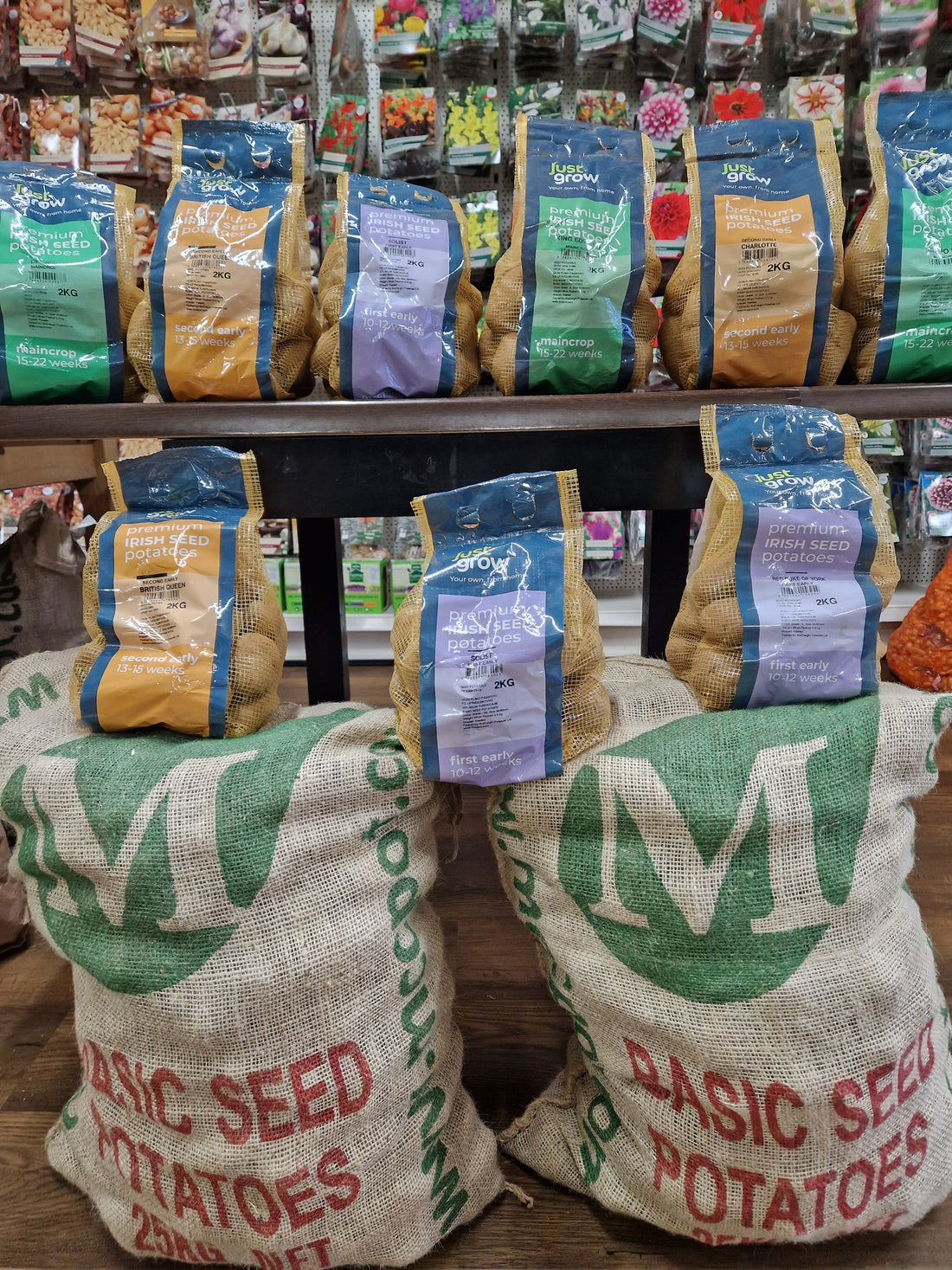In Ireland we love our spuds and there’s nothing better than the taste and satisfaction of your own home grown crop. Potatoes are easy enough to grow and if you haven’t tried them yet you should definitely give it a go. They can be grown in containers if digging the ground is not an option so there’s no excuse not to get planting.
Traditionally around St Patrick’s Day is a time to look at planting your seed potatoes but we encourage our customers to buy them early as, if you leave it too late to buy them a lot of the popular or favorite varieties will be sold out - so buy early to have the best choice and selection.
Types of potatoes include first earlies, second earlies and main crop with lots of varieties in each type. First earlies, as the name suggests are the first to be harvested and are usually planted around mid to late March. Second earlies come next, they stay in the ground a bit longer and are usually planted around early April and Main crop seed potatoes take the longest to be ready to harvest and get planted around mid April.
Your first early varieties will be ready to harvest around June or July, second earlies around July and August and the main crop varieties are ready to lift from late August through to October. Early varieties don’t store as well so are best eaten fresh whereas main crop will store for longer.
So keep it in mind when you are planning, what to plant and where you’ll plant it, how long they’ll be in the ground and if you’ll want space for growing other crops - first early varieties will be in the ground for a shorter length of time and take up less space and have a smaller yield - so these varieties can be ideal for growing in containers or where space is limited - where main crops take up more space and will have a lot bigger yield.
Planting seed potatoes is done after the threat of a hard frost has passed but they can tolerate a light frost - usually with a soil temperature around 9 or 10 degrees and in soil that is not too wet, preferably in a nice sunny location in the garden. As potatoes do so much of their growing underground you don’t want to plant in heavy, compacted soil. Digging in plenty of compost and well rotted manure before planting will be of huge benefit to your crop later on.
Different Varieties
First early favorites for me are Home Guard or Orla - Orla is an excellent variety that is blight resistant and a great tasting variety, lovely baked. It can also be left in the ground longer and grown on as a second early
Second Early varieties that are popular are British Queens, excellent for taste and flavour, Maris Piper, great for chips and roast potatoes & Charlotte - great salad potato and a versatile great all-rounder that can be cooked in lots of different ways.
Main Crops that we love to grow include Roosters and Records, lovely floury texture and great taste - Kelly is a great maincrop that has great resistant to blight,stores really well and is a great all rounder for cooking
No harm in sticking to the tried and tested or traditional varieties but I’d encourage trying out a new variety each year - you might discover a new favorite !
Before planting your seed potatoes you should “Chitt” them - or allow them to sprout - this can help give you an early harvest and a bigger yield. You can place your seed potatoes on an egg carton or seed tray with the end with the most eyes facing upwards. Place them in a cool, light spot and allow them to develop short stubby chitts - dark purple in colour - this can take 4 to 6 weeks
When growing potatoes in the ground, plant early and salad types 5 inches deep and about a foot apart, with about 2 feet between rows. Maincrop potatoes require more space to produce a decent crop. Plant them 5 inches deep and 15 inches apart, with 2 and a half feet between rows. Plant potatoes with the shoots (or ‘eyes’) facing upwards.
Once the potato plants start to grow you ‘earth up’ or bring soil up around the stems - this helps to prevent sunlight getting into the tubers which would turn them green and in-edible - it also helps protect the stalks from late frosts and give more room for the potatoes to grow. You can use a spade or a hoe to earth up the plants, leaving a small bit poking out of the top - as the plants continue to grow you keep earthing them up.
If you are growing in bags or containers make sure they have holes for drainage and use a good quality compost with some manure or soil enricher. Fill the container to about 1 third the depth, place the seed potato with the eyes facing upwards and cover over with about 5 inches of your compost mix, one or two seed potatoes to a bag or small container will be plenty - too many will result in very small potatoes.
As the plants grow, earth them up by topping up the container or bag with your compost mix - you’ll do this 2 or 3 times until the soil comes to almost the top of the bag - if is very important to keep the seed potatoes well watered by watering them regularly
Potato blight can be a problem but you can overcome this by planting some of the blight resistant varieties - Orla, Sarpo varieties and Kelly - you can also keep an eye out for blight warnings - Met Eireann are good for this and you can spray the plants in advance to protect them from getting blight. Slugs can sometimes be a problem - plenty of organic slug pellets available if needed
Harvesting your seed potatoes is the time most of us enjoy the most - first earlies are best dug as and when you need them - usually after about 10 or 12 weeks after planting, depending on soil and weather etc… they might be flowering or just finished flowering - you can carefully dig with a fork to check them - they should be of a medium size - little bit bigger than a hens egg. Similar with second earlies ready about 12 or 13 weeks after planting and best dug or lifted as required as they don’t store very well - but can be left in the ground and lifted when needed - if you have more than you need I’m sure neighbours or friends will be delighted with a bucket or 2 of fresh homegrown spuds. Main crops are ready around about 20 weeks after planting - this can be from August to October - depending on when they were planted - main crops tend to store better - keep them in a cool, frost free place and only store undamaged potatoes - paper bags or hessian sacks can be used to keep the light from getting into your crop. A few different varieties to keep an eye out for include Purple Rain - high in antioxidants, great for chips and mash with a purple skin and flesh - or Irish Gold - a newish variety grown in north county Dublin great all-rounder, fantastic flavour and yield and also high in antioxidants being hailed as somewhat of a superfood
So, call into your local garden centre or give us a shout in Keane’s - we have plenty of varieties to choose from and we’ll give you lots of advice and hints and tips
A few jobs for the week ahead;
- Onion sets and shallots and garlic are all available to buy at this time of year - pick up your favorite varieties and even try a new type - you’ll see them close to the seed potatoes
- With Spring soon approaching you can dig some farmyard manure into beds to condition and enrich your soil - they’re on offer at the moment buy 2 get 3rd free
- Summer flowering bulbs are available to buy this time of year - Dahlia, begonias, Lilies, Agapanthus and Gladioli - all great for Summer colour and easy to grow

